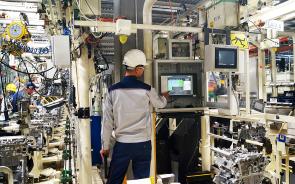Vehicle production moves up a gear with advanced network technologies
The automotive industry has continually pioneered new manufacturing and assembly processes, driving the adoption of key innovative technologies on the factory floor. To enhance their competitiveness, companies need interconnected and flexible production systems that can decrease cycle times while increasing quality. Industrial communication technologies play a key role in the successful implementation of complete solutions for data/information integration.
John Browett, General Manager at CLPA Europe, discusses the key features of ideal network solutions for the automotive industry.
The automotive sector is often an early adopter of innovative technologies and as a result it is one of the most automated manufacturing industries in the world. It is the main driver and largest segment of the industrial robotics industry, accounting for 34% of the over 2.7 million robot installations worldwide1.
The use of advanced automated systems allows businesses in the sector to maintain low cycle times that support high-volume, fast turnaround production with improved quality. For example, thanks to technology, it takes 13 to 35 hours to turn raw materials into a car that comprises tens of thousands of parts. Key applications that car makers currently automate include welding, injection moulding, painting and surface coating, glue dispensing, assembly and inspection.
Similarly, automotive manufacturers can support large-scale mixed model production programs in their assembly. As a result, businesses can effectively use a single production line to deliver different vehicle models with a high degree of customisation.
Smarter, better, faster
As new, promising digital technologies emerge and develop, they are often adopted by automotive manufacturers to optimise various aspects of production. Currently, one of the most common ambitions among manufacturers is the creation of flexible systems that can autonomously run entire production processes, self-optimise their performance across a broader network and adapt to varying conditions in real or near-real time.
Even following this trend, the automotive sector is ahead of the curve, with 30% of factories in the industry already converted to smart factories and a further 44% expected within the next five years2. This results in over 70% of vehicle manufacturers currently involved in this initiative2.
At the heart of Connected Industry applications are large volumes of data, which are generated, shared and analysed in order to offer a unique insight into machines, processes and facilities as well as supporting automated closed-loop feedback control. Therefore, the implementation of a highly advanced networking technology to connect multiple parties and share information is paramount to set up intelligent, interconnected plants. When implementing automated systems, businesses require a high-performance, secure and reliable networking technology in order to get the necessary data from factory floor devices, which are otherwise disconnected, to set up Industry 4.0 applications.
The key needs of connected industries
The automation specialist needs to select and use automation devices that leverage a state-of-the-art industrial communication technology that can support the real functionalities of data-driven applications. Key elements that automation specialists should include in their products are interconnectivity and the use of a network solution that features sufficient and well-utilised bandwidth as well as the ability to support the convergence of information technology (IT) and operational technology (OT).
The first aspect enables automation products to communicate and interact with other devices within an enterprise, e.g. supporting effective field-level communications. Optimal level and allocation of network bandwidth, on the other hand, allows automation devices within a network to effectively handle the ever-increasing traffic of data generated by smart machines while minimising latency and jitter during transfer.
Toyota’s plant in Wałbrzych, Poland, the company’s biggest engine and transmission manufacturing operation in Europe, was able to increase the availability of its production lines and improve the transparency of data by selecting a network technology with these features. In particular, the chosen solution, CC-Link IE open industrial gigabit Ethernet, ensured the necessary level of performance was met thanks to its large bandwidth, and its openness allowed it to seamlessly integrate multiple devices from a range of different vendors.
Network technologies for maximum performance
The latest evolution of CC-Link IE, CC-Link IE TSN, further enhances the network’s capabilities and allow manufacturers of automation products to address current and future needs. The technology is an open industrial Ethernet technology that combines 1 gigabit/second bandwidth and Time-Sensitive Networking (TSN). By selecting it for their products, device makers can leverage a widely adopted technology with the highest bandwidth currently available as well as TSN features to support IT/OT convergence.
Automotive plants that use CC-Link IE TSN compatible automation devices can therefore fully realise smart, interconnected factories, reaching the next level in productivity and performance. In particular, businesses will be able to further reduce their cycle times and production costs and increase flexibility to deliver vehicles with a high degree of customisation and quality.
About The CC-Link Partner Association (CLPA)
The CLPA is an international organisation founded in 2000 dedicated to the technical development and promotion of the CC-Link family of open automation networks. The CLPA's key technology is CC-Link IE TSN, the world's first open industrial Ethernet to combine gigabit bandwidth with Time Sensitive Networking (TSN), making it the leading solution for Industry 4.0 applications. Currently the CLPA has over 3,800 member companies worldwide, and more than 2,000 compatible products available from over 300 manufacturers. Over 26 million devices using CLPA technology are in use worldwide.
Editorial contact:
DMA Europa Ltd: Anne-Marie Howe
Tel: +44 (0)1562 751436 Fax: +44 (0)1562 748315
Web: www.dmaeuropa.com Email: anne-marie@dmaeuropa.com
Company contact:
CLPA-Europe: John Browett
Tel: +44 (0) 7768 338708 Fax: +49 (0) 2102 532 9740
Web: eu.cc-link.org Email: john.browett@eu.cc-link.org
1 International Federation of Robotics (2020) Executive Summary World Robotics 2020 Industrial Robots. Available at: https://ifr.org/img/worldrobotics/Executive_Summary_WR_2020_Industrial_Robots_1.pdf [Accessed: 2 December 2020]
2 Capgemini Research Institute (2020) How automotive organisations can maximise the smart factory potential. Available at: https://www.capgemini.com/gb-en/wp-content/uploads/sites/3/2020/02/Report-%E2%80%93-Auto-Smart-Factories-1.pdf [Accessed: 14 August 2020]

The automotive sector is often an early adopter of innovative technologies and as a result it is one of the most automated manufacturing industries in the world.
- Association de Partenaires CC-Link (CLPA)
Espace membre 



